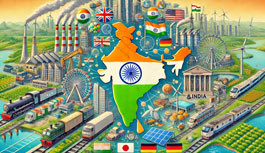India’s Industrial Growth Since Independence: The Role of State-Owned Enterprises, Private Sector, and Overseas Collaboration
Introduction

India’s industrialization journey post-independence (1947) has been marked by transformation and resilience. Emerging from a predominantly agrarian economy with limited infrastructure, India embarked on a mission to build a self-reliant industrial base. Over the decades, it has grown into one of the world’s largest economies, with a robust industrial sector driving its growth. This newsletter highlights the role of state-owned enterprises (SOEs), private companies, and international collaborations with Russia, UK, Germany, and the USA in shaping India’s industrial landscape.
Industrial Growth Anchored by a Skilled Workforce
India’s industrial and administrative growth is underpinned by its highly skilled workforce. Elite cadres such as the Indian Administrative, Civil, Police, Foreign, Forest, and Medical Services have played pivotal roles in policymaking, law enforcement, and healthcare. Specialized groups like Indian Engineering, Railway, Military, Navy, and Transport Services contribute significantly to infrastructure development and economic growth. These cadres are supported by rigorous training and merit-based recruitment, fostering sustainable development and resilience. A role model example is R.C. Bhargava, former IAS officer and CEO of Maruti Suzuki, who transformed Suzuki into a highly successful company in India through visionary leadership and market expertise.
The Emergence of State-Owned Enterprises (SOEs)
At independence, India faced the immense challenge of building an industrial base to achieve self-reliance, create jobs, and reduce poverty. The government-initiated projects in strategic sectors such as steel, coal, power, oil, heavy industry, and telecommunications. Over 25 SOEs were established, including Bharat Heavy Electricals Limited (BHEL), Steel Authority of India Limited (SAIL), Indian Oil Corporation (IOC), National Thermal Power Corporation (NTPC), and Air India, other.
These enterprises reduced foreign dependency and supported infrastructure development. For example:
- Steel Plants: Collaborations with the Soviet Union, UK, and Germany enabled the construction of plants in Bhilai, Rourkela, and Durgapur, with Bokaro Steel Plant built with Soviet support.
- SAIL’s Role: Established in 1973, SAIL managed integrated steel plants and ensured sufficient supply for infrastructure, railways, and power.
- BHEL: With Soviet collaboration, BHEL spearheaded heavy machinery and turbine production, becoming a cornerstone of India’s heavy engineering sector. These SOEs not only created jobs and boosted economic development but also ensured national security by retaining control over strategic industries.
Government Policy and Overseas Collaboration
Foreign partnerships were instrumental in India’s industrial growth. The Soviet Union provided technology and expertise for building steel plants, Military and Nuclear power stations, while Western countries like the USA and UK contributed to sectors such as defense, civil engineering, and telecommunications. The Indian Railways benefited significantly from overseas technological assistance, enabling the creation of one of the world’s largest rail networks.
These collaborations extended beyond technology transfers to include financial investments and joint ventures. For example, partnerships with Japan and Germany supported the development of automobile manufacturing and advanced machinery. Over time, India’s reliance on foreign expertise diminished as domestic capabilities expanded, particularly in fields like electronics and telecommunications.
Diversification into Emerging Sectors
As India’s industrial base matured, it diversified into sectors such as automobiles, electronics, telecommunications, and pharmaceuticals, each contributing significantly to the economy:
- Automobiles: Early manufacturers like Hindustan Motors laid the foundation, Maruti Suzuki partnership revolutionized the industry by blending Japanese expertise. Tata Motors and Mahindra emerged as global leaders, producing world-class vehicles and boosting exports.
- Telecommunications: Early government initiatives, coupled with private sector innovations, made mobile and internet connectivity widely accessible. By the 1990s, companies like Bharti Airtel and Reliance Communications transformed the sector.
- Pharmaceuticals: Leveraging technology transfers, India became a global leader in generic medicines, supplying affordable drugs worldwide. This sector now contributes significantly to global healthcare.
- IT: Capitalizing on an English-speaking workforce, India emerged as a global IT hub. Companies like Infosys, Wipro, and TCS pioneered outsourcing, consulting, and digital transformation services, establishing India as a leader in technology-driven solutions.
The Role of Private Enterprises
India’s industrial growth has been equally driven by its private sector. Iconic companies like Tata Group, Reliance Industries, and Mahindra & Mahindra have been instrumental in innovation, job creation, and global competitiveness:
- Tata Group: A trailblazer in steel, energy, and IT, Tata’s global expansions and innovations have made it a cornerstone of modern India.
- Reliance Industries: Pioneering in petrochemicals, refining, and retail, Reliance revolutionized digital connectivity with Jio, transforming India’s digital economy.
- Mahindra & Mahindra: A leader in automobiles and tractors, Mahindra has advanced rural development and contributed to defense manufacturing.
- Bajaj Group: Renowned for affordable two-wheelers, Bajaj has expanded into renewable energy and financial services, supporting industrial and consumer growth.
- Corporate Social Responsibility (CSR) has been a part of Indian philosophy since ancient times, rooted in the Hindu concept of Karma. Historically, kings, wealthy individuals, and businesspeople supported society by building schools, hospitals, and orphanages. The Tata Group is a prime example, continuing this legacy of philanthropy. My father, a small entrepreneur, also embodied this spirit by founding a school in our village, inspired by his own struggles of walking 15 km to attend school. In those days, an entrepreneur’s success was measured by their contributions to society, not by sales figures.
Pharmaceutical and Healthcare Sector
India’s pharmaceutical sector exemplifies its industrial success. Post-independence, the government prioritized healthcare infrastructure to meet the needs of a growing population. Collaborations with multinational pharmaceutical companies facilitated technology transfers that propelled India into a global leadership position in generic drug production. Today, India supplies over 50% of global vaccine demand and exports medicines worldwide. Companies like Dr. Reddy’s, Cipla, and Sun Pharma have gained global recognition, supported by strong R&D capabilities and competitive pricing.
“Make in India”: A Strategic Initiative
Launched in 2014, Prime Minister Narendra Modi’s “Make in India” initiative aims to transform India into a global manufacturing hub. Targeting sectors like electronics, defense, and textiles, the program has improved ease of doing business, attracted foreign direct investment (FDI), and promoted skill development. The initiative aligns with “Digital India” and “Skill India” to harness the nation’s demographic dividend, fostering growth and innovation across industries.
Challenges in Infrastructure and Cold Chain Logistics
Despite its successes, India faces significant infrastructure challenges, particularly in cold chain logistics. A staggering ~40% of agricultural produce is lost annually due to inadequate cold chain facilities, leading to opportunity losses in food processing and energy demand mismatches. This issue underscores the need for public-private partnerships and strategic investments in logistics to minimize waste and enhance efficiency. Additionally, bureaucratic inefficiencies, delays in major projects like the Bullet Train and Dedicated Freight Corridor, and a lack of operational discipline highlight systemic issues requiring urgent attention.
Conclusion
India’s industrial growth is a testament to collaboration between state-owned enterprises, private companies, and international partnerships. While SOEs laid the foundation for critical sectors, private enterprises and global alliances drove diversification and innovation. However, challenges like inadequate infrastructure, especially in cold chain logistics, and delayed projects hinder growth potential. Addressing these gaps with a focus on sustainability, technological advancement, and operational discipline is crucial. By tackling these issues, India can sustain its industrial momentum and solidify its position as a global economic powerhouse.
Profile
Pankaj Garg
CEO Innovation Thru Energy Co., Ltd, (ITE)

Pankaj Garg holds a degree in Computer Science Engineering from the National Institute of Technology and an MBA in Marketing from Fox Business School, USA. He embarked on his journey to Japan 34 years ago and, over the past 34+ years, has built a distinguished career specializing in AI, robotics, semiconductors, applied engineering, and new product invention and development. He has contributed his expertise to prestigious organizations such as Kobe Steel, Yaskawa Electric, Cirrus Logic, Intel, and NASA/Caltech startups. His broad skill set encompasses R&D, engineering, product manufacturing, and global technical sales and marketing.
Pankaj also holds over 30 patents in the areas of semiconductors, green energy, and next-generation energy, reflecting his innovative contributions to these cutting-edge industries.
Driven by a mission to tackle critical global challenges like climate change, food waste, and pharmaceutical cold chain deficiencies, Pankaj set out to create a seamless, globally standardized cold chain logistics system. After leaving Intel, he founded ITE Co., Ltd. in 2007, entirely self-funded. Today, ITE serves over 250 clients globally, with a growing presence in the Indian market. Inspired by Japan’s dedication to innovation and craftsmanship, Pankaj has fostered a culture of excellence, integrity, and continuous improvement at ITE. His guiding principles are drawn from the teachings of Karma (as outlined in the Bhagavad Gita) and Kaizen, along with his extensive global business experience, particularly in the U.S., which shape ITE’s customer-first philosophy.
Pankaj possesses deep expertise in areas such as Digital Transformation (DX), semiconductors, the food retail industry, medical cold chains, pharmaceuticals, GDP/GMP standards, life sciences, cold chain logistics value chains, Ayurveda, yoga, and the food industry. This diverse knowledge has been instrumental in his success across multiple domains, positioning him as a visionary leader in cold chain logistics, climate change initiatives, and the green energy sector. Under his leadership, ITE stands as a testament to his technical expertise, entrepreneurial spirit, and commitment to solving global challenges.
Innovation Thru Energy Co., Ltd.
Since its establishment in 2007, Innovation Thru Energy Co., Ltd. (ITE) has been a company specializing in temperature management, providing its unique IceBattery(R) System—a comprehensive cold chain logistics platform and DX solutions—to over 250 companies worldwide. All IceBattery(R) products are designed and developed in-house. The IceBattery(R) System is a revolutionary cooling system capable of maintaining uniform internal temperatures for extended periods across all modes of transportation, from 4L boxes to 40FT large containers/trucks.
For this column
Having spent over 35 years in Japan, my perspective on the country, its culture, and its people is shaped by a unique blend of an Indian heritage and deep integration into Japanese society. My family’s global ties, including my grandfather’s role as Vice Ambassador to Japan in 1959, have instilled in me a broad, inclusive worldview.
I see Japan and India as deeply complementary, with shared values and a synergistic relationship rooted in history, culture, and religion. Japan’s support for India during World War II and the spiritual connections between the two nations underscore this bond.
I believe in harnessing this synergy to create a powerful partnership where India’s global leadership and Japan’s excellence in business, manufacturing, and operational efficiency can unite. Together, we can forge a path towards a future that embodies the true essence of Buddhism and Karma—bringing peace, prosperity, and wisdom to the world as one united family.
contents
- 【Unlocking New Possibilities through Market Characteristics and Cultural Understanding in India】1.A Journey Through India’s History and Cultural Ethos Pankaj Garg – CEO Innovation Thru Energy Co., Ltd, (ITE)
- 【Unlocking New Possibilities through Market Characteristics and Cultural Understanding in India】2.India’s Strategic Alliances and Global Influence Pankaj Garg – CEO Innovation Thru Energy Co., Ltd, (ITE)
- 【Unlocking New Possibilities through Market Characteristics and Cultural Understanding in India】3.The Evolution of India’s Educational Landscape Pankaj Garg – CEO Innovation Thru Energy Co., Ltd, (ITE)
- 【Unlocking New Possibilities through Market Characteristics and Cultural Understanding in India】4.India’s Industrial Growth Since Independence: The Role of State-Owned Enterprises, Private Sector, and Overseas Collaboration Pankaj Garg – CEO Innovation Thru Energy Co., Ltd, (ITE)
- 【Unlocking New Possibilities through Market Characteristics and Cultural Understanding in India】5.India’s Healthcare System: A Comprehensive Overview Pankaj Garg – CEO Innovation Thru Energy Co., Ltd, (ITE)
- 【Unlocking New Possibilities through Market Characteristics and Cultural Understanding in India】6.Introduction to Ayurveda Pankaj Garg – CEO Innovation Thru Energy Co., Ltd, (ITE)
- 【Unlocking New Possibilities through Market Characteristics and Cultural Understanding in India】7.Ayurveda for a Healthy and Balanced Life Pankaj Garg – CEO Innovation Thru Energy Co., Ltd, (ITE)




















